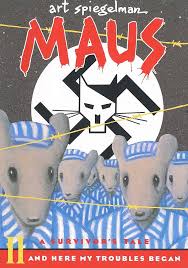The Impact of “Maus” by Art Spiegelman on Comics and Literature
Art Spiegelman’s graphic novel “Maus” stands as a groundbreaking work that revolutionised the way we perceive comics and literature. Originally published in 1986, “Maus” tells the harrowing story of Spiegelman’s father’s experiences as a Polish Jew during the Holocaust, with Jews depicted as mice and Nazis as cats.
This unique approach to storytelling not only garnered critical acclaim but also challenged the boundaries of what comics could achieve. By blending historical accounts with personal narratives, Spiegelman created a powerful and emotionally resonant work that transcended traditional comic book conventions.
“Maus” not only won a Pulitzer Prize but also played a pivotal role in elevating the status of graphic novels as a legitimate form of literature. It demonstrated that comics could tackle complex subjects with depth and nuance, paving the way for a new wave of graphic novels that explore themes ranging from history and politics to personal identity and social issues.
Spiegelman’s meticulous attention to detail in both his storytelling and artwork set a new standard for graphic storytelling. The use of stark black-and-white illustrations combined with a non-linear narrative structure created a haunting atmosphere that lingered long after the final page was turned.
Decades after its initial publication, “Maus” continues to be studied in schools and universities worldwide, cementing its status as a timeless masterpiece that resonates across generations. Its impact on comics and literature is undeniable, inspiring countless artists and writers to push the boundaries of storytelling through visual means.
In conclusion, Art Spiegelman’s “Maus” remains a seminal work that has left an indelible mark on both the world of comics and literature at large. Its legacy serves as a testament to the enduring power of storytelling through art, reminding us of the importance of bearing witness to history through creative expression.
Understanding Maus: Key Questions Answered
- Why was the Maus removed?
- What age can you read Maus?
- What is the main point of Maus?
- Is Maus based off a true story?
- What was the story Maus about?
Why was the Maus removed?
The question of why “Maus” was removed is a common inquiry that often arises due to the controversial nature of the graphic novel’s subject matter. While “Maus” has faced challenges and bans in some educational settings or libraries, it is important to note that these removals are often due to concerns about its depiction of sensitive themes such as the Holocaust, rather than any inherent flaw in the work itself. The graphic novel’s unflinching portrayal of historical events and its unconventional approach to storytelling have sparked debates about appropriateness and censorship, highlighting the complex relationship between art, history, and public perception.
What age can you read Maus?
The graphic novel “Maus” by Art Spiegelman is a powerful and thought-provoking work that delves into the sensitive subject matter of the Holocaust. Due to its mature themes, including depictions of violence and historical atrocities, “Maus” is generally recommended for older readers, typically teenagers and adults. Parents and educators are advised to consider the emotional maturity and sensitivity of individual readers before introducing them to the book, as its content may be distressing or difficult for younger audiences to fully comprehend. It is important to approach “Maus” with care and provide appropriate context and support for readers of any age who engage with this significant work.
What is the main point of Maus?
In Art Spiegelman’s graphic novel “Maus,” the main point revolves around the exploration of the Holocaust experience through a unique and poignant lens. By portraying Jews as mice and Nazis as cats, Spiegelman delves into the complexities of survival, trauma, guilt, and resilience in the face of unimaginable horrors. The narrative not only chronicles the harrowing events of the Holocaust but also delves into themes of generational trauma, family dynamics, and the enduring impact of history on individuals. Ultimately, “Maus” serves as a powerful testimony to the human spirit’s ability to endure and find meaning amidst profound suffering.
Is Maus based off a true story?
The graphic novel “Maus” by Art Spiegelman is indeed based on a true story. Spiegelman’s work is a semi-autobiographical account that delves into his father’s experiences as a Polish Jew during the Holocaust. Through the use of anthropomorphic characters, with Jews depicted as mice and Nazis as cats, Spiegelman masterfully weaves together historical events with personal narratives to create a poignant and powerful portrayal of survival, trauma, and resilience. The authenticity and emotional depth of “Maus” stem from Spiegelman’s commitment to honouring his family’s history and bearing witness to the atrocities of the Holocaust through the medium of comics.
What was the story Maus about?
“Maus” by Art Spiegelman is a poignant graphic novel that recounts the experiences of the author’s father, a Polish Jew, during the Holocaust. The story unfolds through a unique narrative device where Jews are depicted as mice and Nazis as cats, offering a powerful allegory of the atrocities of World War II. Through this compelling visual metaphor, Spiegelman masterfully weaves together personal accounts with historical events, creating a deeply moving and thought-provoking exploration of survival, trauma, and resilience in the face of unimaginable horrors. “Maus” is not just a story about survival during one of humanity’s darkest periods; it is a testament to the enduring power of storytelling and the indomitable human spirit in the face of adversity.


Leave a Reply